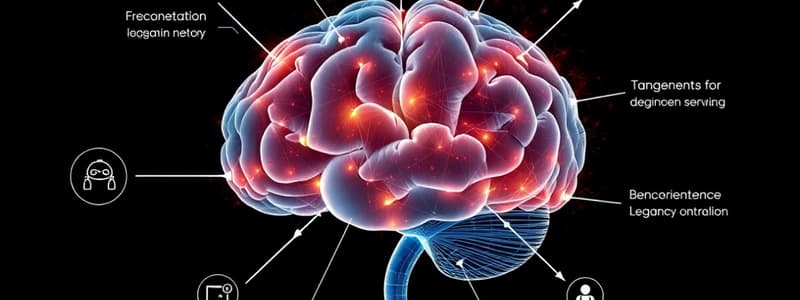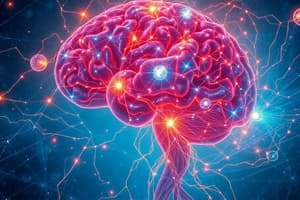Podcast
Questions and Answers
What defines learning in psychological terms?
What defines learning in psychological terms?
- An involuntary reaction to stimuli.
- A temporary change in behavior due to external factors.
- A static state of knowledge acquisition.
- A long-lasting change in behavior resulting from experience. (correct)
Which brain region is primarily associated with memory consolidation?
Which brain region is primarily associated with memory consolidation?
- Frontal Lobe
- Cerebellum
- Hippocampus (correct)
- Amygdala
In classical conditioning, what is a conditioned stimulus (CS)?
In classical conditioning, what is a conditioned stimulus (CS)?
- A neutral stimulus that becomes associated with an unconditioned stimulus. (correct)
- A reflexive response to an unconditioned stimulus.
- A stimulus that naturally triggers a response.
- An automatic reaction to a conditioned stimulus.
What does the Rescorla-Wagner model explain?
What does the Rescorla-Wagner model explain?
What principle does the Law of Effect primarily emphasize?
What principle does the Law of Effect primarily emphasize?
Which term describes the phenomenon where an organism learns to respond differently to similar stimuli?
Which term describes the phenomenon where an organism learns to respond differently to similar stimuli?
What is the role of neurons in learning and memory?
What is the role of neurons in learning and memory?
What does the term 'blocking' refer to in classical conditioning?
What does the term 'blocking' refer to in classical conditioning?
What does the term 'Conditioned Stimulus' (CS) refer to?
What does the term 'Conditioned Stimulus' (CS) refer to?
During which phase does the Conditioned Response (CR) become stronger through the pairing of the CS and US?
During which phase does the Conditioned Response (CR) become stronger through the pairing of the CS and US?
What occurs during the process of extinction?
What occurs during the process of extinction?
Which statement best describes 'generalization' in classical conditioning?
Which statement best describes 'generalization' in classical conditioning?
In the context of the Little Albert experiment, what was demonstrated?
In the context of the Little Albert experiment, what was demonstrated?
According to the Rescorla-Wagner theory, what influences the change in associative strength?
According to the Rescorla-Wagner theory, what influences the change in associative strength?
What differentiates Stimulus-Response (S-R) associations from Stimulus-Stimulus (S-S) associations?
What differentiates Stimulus-Response (S-R) associations from Stimulus-Stimulus (S-S) associations?
In sensory preconditioning, how are the two stimuli related?
In sensory preconditioning, how are the two stimuli related?
Flashcards are hidden until you start studying
Study Notes
Learning and Memory Basics
- Learning involves lasting changes in behavior driven by experience.
- Memory acts as a recording system for experiences that facilitate learning.
- Key terms include Unconditioned Response (UR), Conditioned Response (CR), Unconditioned Stimulus (US), and Conditioned Stimulus (CS).
Important Figures
- Ebbinghaus researched the forgetting curve and conducted practice experiments.
- Pavlov is known for pioneering classical conditioning concepts using US, UR, CS, and CR.
- Thorndike formulated the Law of Effect and Instrumental Conditioning.
Theoretical Approaches
- Behaviorism emphasizes observable behavior changes through reinforcement, as seen in works by Pavlov and Skinner.
- Cognitive Psychology studies the impact of mental processes, including memory, on behavior, characterized by Tolman's cognitive maps.
Classical Conditioning
- Generalization occurs when organisms react similarly to stimuli akin to the CS; discrimination allows distinct responses.
- Blocking refers to a more potent stimulus overshadowing another, hindering new associations.
Classical Conditioning Paradigms
- Rescorla-Wagner Model explains association formation between CS and US, which adjusts based on trial outcomes.
- Second-Order Conditioning enables pairing a new stimulus with an established CS to elicit a CR.
- Sensory Preconditioning involves prior pairing of two neutral stimuli resulting in a conditioned response later.
Neural Basis of Learning and Memory
- The cerebellum plays a vital role in motor control and learning.
- The hippocampus is essential for memory consolidation.
- Synaptic connections among neurons are crucial for learning processes.
Classical Conditioning in Simple Organisms
- Studies with sea slugs have demonstrated synaptic changes associated with learning.
Classical Conditioning Basics
- Classical conditioning occurs when a neutral stimulus becomes linked to a response through repeated pairing with a US.
- Unconditioned Stimulus (US) naturally elicits a response, while a Conditioned Stimulus (CS) becomes associated with the response after conditioning.
- The resulting Conditioned Response (CR) follows exposure to the CS.
Processes of Classical Conditioning
- Acquisition marks the phase of pairing CS with US, strengthening the CR.
- Extinction happens when the CS is presented without the US, causing a reduction in CR.
- Generalization results in similar stimuli eliciting the CR.
- Discrimination allows for recognition of differences among stimuli to respond to only the CS.
Key Experiments
- Eye-blink conditioning illustrated this process, using an air puff (US) to evoke a blink (UR/CR) connected to a tone or light (CS).
- The Little Albert experiment showcased generalization, where a child developed fear towards a white rat (CS) and related furry objects.
Sensitization and Habituation
- Sensitization involves an increase in response to a stimulus after repeated exposure.
- Habituation denotes a decrease in response to a stimulus over time.
Neural Basis of Classical Conditioning
- Research on the sea slug Aplysia explores synaptic connections changing during learning.
- Facilitating interneurons release neurotransmitters, enhancing responses during conditioning.
Rescorla-Wagner Theory
- Suggests learning is influenced by the unexpectedness of the US.
- Formula ΔV = α(λ - V) describes the change in associative strength (ΔV) based on the learning rate (α) and the difference between maximum association (λ) and current strength (V).
- Blocking effect prevents formation of new associations if an established CS is a better predictor for the US.
S-R vs. S-S Associations
- S-R (Stimulus-Response) describes the direct elicitation of UR by CS.
- S-S (Stimulus-Stimulus) indicates that CR arises from the anticipation of US predicted by CS.
Key Paradigms
- Sensory Preconditioning pairs two stimuli before one links to a US, leading to a response with subsequent presentations of either.
- Second-Order Conditioning introduces a new stimulus associated with the CS, also prompting the CR.
Studying That Suits You
Use AI to generate personalized quizzes and flashcards to suit your learning preferences.



